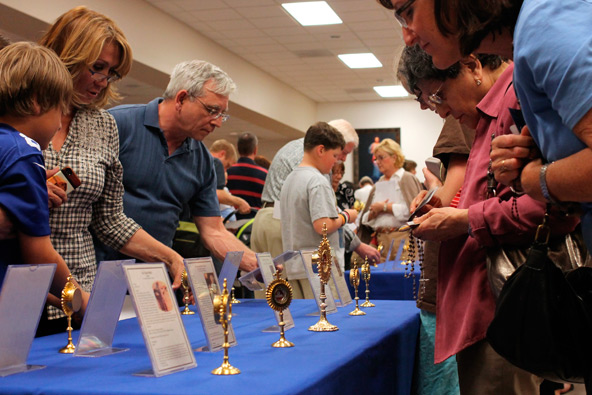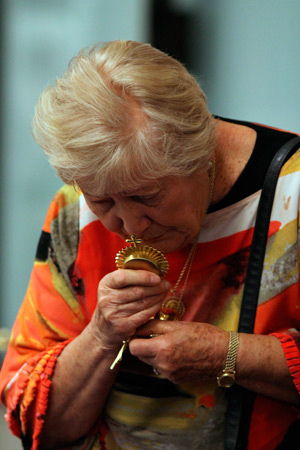
Fr. Carlos Martins, CC, has an unusual collection: 4,000 relics of the saints. The Companions of the Cross Father and former atheist, who lives in Toronto, travels throughout North America with his “Treasures of the Church” exhibit that features some 175 relics.

Last month, Fr. Martins visited six parishes in the Diocese of Phoenix. It was his second tour of the diocese in two years and the faithful came out in droves to hear his hour-long presentation, followed by a chance to venerate the relics.
There was a piece of wood from the True Cross of Christ, a portion of the Blessed Virgin Mary’s veil and even a fragment of the crown of thorns worn by Jesus.
Mostly, the relics were chips of bone encased in reliquaries, displayed along with biographical information about the saint or beatified person known as a “blessed.” Many were instantly recognizable, such as that of St. Francis of Assisi, St. Dominic and St. Thomas Aquinas. Others were lesser known individuals such as St. Longinus and St. Veronica Giuliani.
So what are relics and why do Catholics hold them in such high esteem?
Relics are physical objects that have a direct association with the saints or with Jesus Christ. They are divided into first, second and third classes.
A first-class relic is a fragment of a bone or the flesh of a saint or blessed. A second-class relic is something — or part of something — that belonged to a saint or blessed, such as an article of clothing or a book. A third-class relic is something that was touched by a saint or blessed or a devotional item such as a rosary or medal that has been touched to a first, second or another third-class relic.
At St. Timothy Parish in Mesa, the faithful listened in rapt attention as Fr. Martins described the martyrdom of St. Maria Goretti and the many healings that have taken place when people venerate the relics he displays. Some brought rosaries, medals and even pictures of their loved ones to touch to the relics.
The veneration of relics, Fr. Martins explained, has biblical roots. God likes to work through His creatures and often heals people through these experiences.
In the book of Kings, for example, the corpse of a man is touched to the bones of the prophet Elisha and the man miraculously came back to life. In Acts, a woman who suffered from a hemorrhage for years touched the hem of Jesus’ cloak and was instantly healed. Later, handkerchiefs or aprons that had been touched by Paul were applied to the sick. They too were healed.
So have there been any healings at Fr. Martin’s exhibits?
“If there aren’t any healings,” Fr. Martins said, “I consider the evening a failure.”
His website, treasuresofthechurch.com, has numerous testimonials from people who prayed in front of the relics and experienced healing. One little girl, Fr. Martins said, had a large tumor which disappeared.
If the Church requires that the cremated remains of the deceased must be laid to rest and not kept at home or scattered, how is it that the veneration of relics is permitted?
“The body is a holy and sacred thing created by God, so it needs to be treated reverently—it needs to be put in a place of rest. Every human community throughout time has understood this,” Fr. Martins said. Every human body deserves a grave unless something higher intervenes, he explained.
When it comes to relics and the bodies of the saints, they assist the faithful in the worship of God, so in that case, the right that the saints have to a burial is superseded by the right of the faithful to venerate them.
The resurrection of the body, Fr. Martins said, will be a mysterious thing and will not be prevented by the separation of its parts so as to provide relics. The Scriptures state that when Jesus rose from the dead, He passed through walls and when He ate, food stayed in Him.
“So there’s a lot of mystery,” Fr. Martins said. “The fact that a [saint’s] body is spread about is not a hindrance to the resurrection.”
The Church forbids the public veneration of relics unless they have been authenticated. Fr. Martins is one of only three people in North America authorized to authenticate relics.
This reporter presented him with a purported relic of fourth-century martyr St. Lucy. Fr. Martins pried off the back of the reliquary and beheld the unbroken threads and distinctive, red, raised wax seal of a now-deceased postulator of relics. The small chip of bone of St. Lucy had not been tampered with and Fr. Martins declared the relic genuine.






